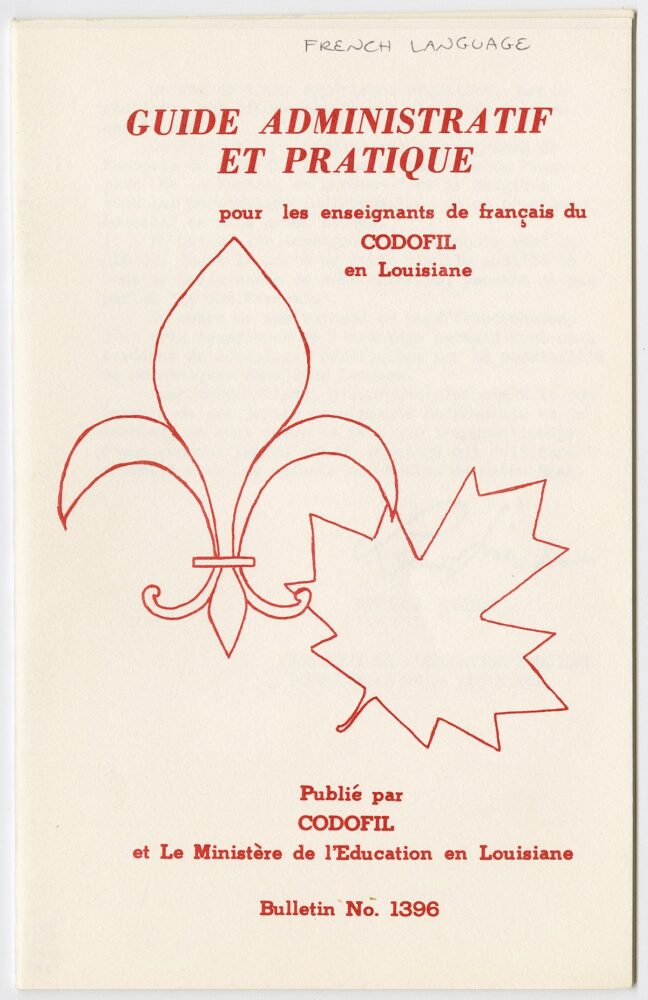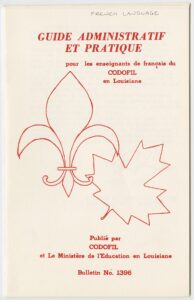Vive le français
Immersion programs seek to arrest French’s retreat from Louisiana
Published: November 28, 2022
Last Updated: February 28, 2023

The Historic New Orleans Collection
An administrative guide for CODOFIL teachers, ca. 1970.
“This is not a Breaux Bridge accent,” Peggy Feehan joked when I called her recently to talk to her about her work. A native of New Brunswick, Canada, Feehan arrived in Louisiana in 1999, one of the cohort of teachers brought here that year by the Lafayette-based Council for the Development of French in Louisiana (CODOFIL). She was looking forward to a temporary escape from harsh Canadian winters. Twenty-three years later, she serves as CODOFIL’s executive director, buoyed by a mission she describes as doing “anything and everything to save French in Louisiana.”
French was the “language of everyday life” in public spheres in Louisiana into the nineteenth century, according to Barry Ancelet, a noted folklorist and professor emeritus of Francophone studies at the University of Louisiana at Lafayette. It was brought here by three distinct channels: French settlers who populated the region in the first half of the eighteenth century; enslaved people who often spoke creoles of French and African languages, developed either locally or in the French-speaking Caribbean; and the Acadians who arrived in Louisiana en masse after their exile by the British from present-day Nova Scotia in 1765.
A convergence of pressures conspired to precipitate the decline of French in Louisiana. According to Ancelet, these included the Louisiana Purchase in 1803, the discovery of oil that attracted an influx of non-French-speaking outsiders to the area, a growing nationalist sentiment across the United States that took off around the time of World War I, and a prohibition on speaking French in Louisiana schools starting in 1916.
The 1990 US Census Bureau’s American Community Survey estimated that about 250,000 Louisiana residents aged five or older spoke a dialect of French at home. That number had dwindled to 142,000 by 2010, and to just 77,000 as of the most recent survey, conducted in 2020. CODOFIL has been tasked with stemming the tide.
Established by the state legislature in 1968, CODOFIL was an outgrowth of what Ancelet describes as a revival in Cajun French music, culture, and ethnic pride that began in the 1940s, when Cajun soldiers deployed to France during World War II found utility in a language that had previously been a source of embarrassment.
Traditionally, CODOFIL teachers have adopted more conventional language-instruction formats, teaching French as a second language in short, standalone classes a few days a week. But about a decade ago, with interest in French immersion growing, the state legislature specifically amended CODOFIL’s mandate, calling for a concerted effort to create more immersion opportunities, particularly across Acadiana.
Today, there are French immersion programs—in which much of the school day is taught in French—stretching across the southern portion of the state, in places like Lake Charles, Mamou, Sunset, Lafayette, Baton Rouge, and New Orleans, where my own children are enrolled in French immersion schools. There are even programs in North Louisiana, a place not typically associated with French culture.
Immersion education is part of a national trend, often driven by parents swayed by research suggesting brain-boosting benefits of bilingualism, among other factors. But the embrace of French immersion is particularly pronounced in Louisiana, where there has been a concerted effort to expand access to these programs in the name of cultural preservation.
About 5,000 Louisiana students were expected to begin the school year in fall 2022 in one of the state’s thirty-two French immersion programs, according to Michele Braud, World Languages Coordinator with the Louisiana Department of Education, which works in partnership with CODOFIL on these initiatives. That’s up 23 percent from a decade earlier, Braud said, and compares with just 400 students enrolled in French immersion in the early 1990s. (The first two pilot immersion programs in Louisiana were launched in the 1980s after policy makers saw the success being had in places like Quebec with this approach, Feehan told me.) Louisiana has a goal of expanding French immersion enrollment by 5 percent each year, Braud said.
As of 2019, Louisiana boasted the largest number of French immersion programs and enrollment in the country, according to a report published by the French government. But enrollment took a hit during the pandemic just as Utah was expanding its programs, and that state—where an estimated 8,000 students are enrolled in immersion programs—overtook Louisiana’s French immersion enrollment numbers last year, according to Mathieu Ausseil, education attaché at the French Embassy in Washington, DC.
Feehan is well aware of the plight of French in Louisiana, but she pushes back on the notion that it’s time to write the obituary on this piece of the state’s culture. “Why do we have five thousand kids in French immersion if it’s dying?” she said. “We are creating a new generation of French speakers.” Ancelet in an email told me he considers French immersion “the last and best chance to preserve French in Louisiana.”
Lycée Français de la Nouvelle-Orléans, one of five French immersion programs in New Orleans, is the first public, accredited French immersion school in the United States serving preschool through high school, according to Kim Conner-Davis, former principal of the lower school campus. Although parents enroll their children for all manner of reasons (one told me the French school was simply the closest, best, free option), Conner-Davis, who grew up in a French-speaking household in Jeanerette, Louisiana, sees the school as part of a noble quest.
French, she said, is not a foreign tongue: “It’s our language.”
Emilie Bahr is a writer, urban planner, Francophile, and mother to young children who lives in New Orleans. Her book Urban Revolutions: A Woman’s Guide to Two-wheeled Transportation, was published in 2016. She can be reached at [email protected].
